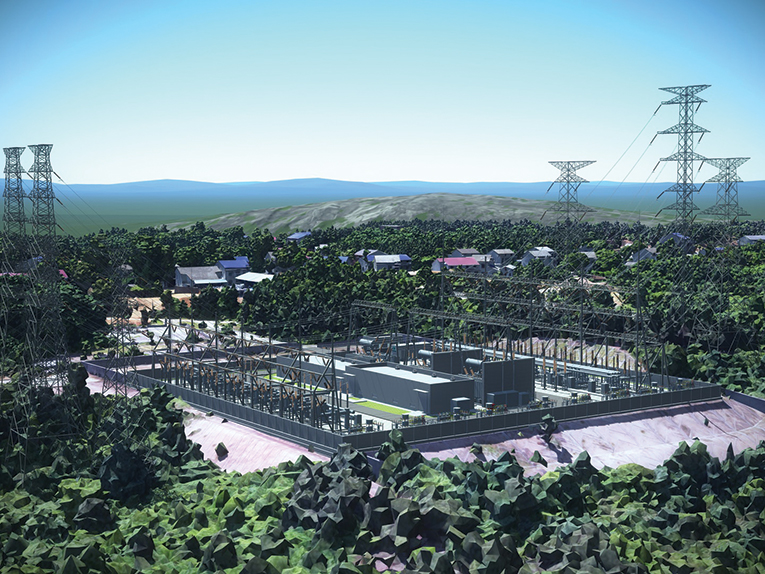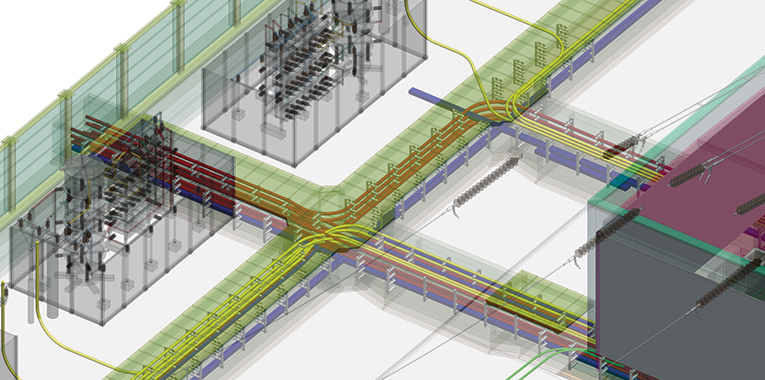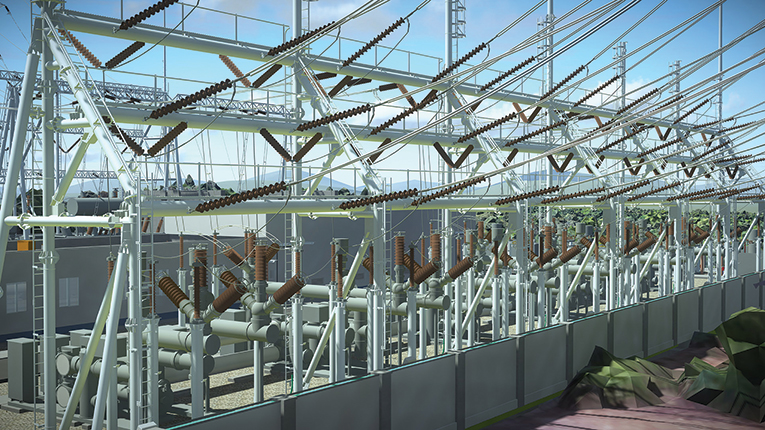Introduction
The State Grid Corporation of China is developing and promoting 3D design standards to digitalize processes for lifecycle substation management throughout the country. The Miluo western 220-kilovolt substation is the organization’s CNY 120 million pilot initiative, and the first substation to use 3D digital modeling throughout construction, operations and maintenance. Located in the Hubei province of China, the substation will significantly improve the grid structure in the Miluo area, covering 16-square kilometers and enhancing the reliability of power supplied to 160,000 residents. POWERCHINA Hubei Electric Engineering Co., Ltd. (HEEC) won the bid as lead designer to implement 3D collaborative modeling in accordance with the State Grid’s design standards and to deliver digital twins to the owner.
Background
The project presented numerous site challenges, including a complex surrounding landscape lined with large residential houses that restricted the layout of the substation facility. To accommodate the compressed footprint, the spatial location of each asset type – including underground works, building structures, electrical equipment and cable trenches – required multiple contributing engineering disciplines in close collaboration. Working against an aggressive 10-month schedule to complete construction, HEEC had to effectively coordinate with each construction organization to safely deliver the project on time. Faced with these design and construction difficulties, the team required integrated BIM, reality modeling, and simulation and visualization technology to apply 3D digital standards and achieve full lifecycle digitalization.
Creating digital context for immersive visualization
To accurately plan the project, HEEC used oblique photogrammetry, captured using an unmanned aerial vehicle, and 3D reality modeling software to survey the substation site and generate a 3D reality mesh. Using geospatial reality modeling helped establish a digital context for the project, visually capturing landscape, vegetation, rivers, lakes, roads and houses surrounding the project area to support substation site and corridor planning. “The 3D reality modeling software generates high-precision reality models automatically and can visually reflect various information to help make decisions,” said Wei Wang, executive assistant, senior engineering at HEEC.
HEEC relied on the accuracy of the 3D reality model to visualize and analyze the existing conditions, optimizing the incoming and outgoing corridor lines while also minimizing impact on agricultural land and houses bordering the substation. Using the reality mesh enabled the team to avoid the demolition of six houses and reduce the area occupied by the substation by 22 percent, saving 0.94 hectares when compared to the original design scheme. As a result, HEEC saved CNY 2.5 million through the optimal substation layout and reduced earthworks for bored and cast-in-place piles by 63 cubic meters to save an additional CNY 90,000.

Compared to traditional 2D drawings, using a reality modeling application provided reliable
environmental information to rationalize the substation layout amid the constrained site.
Collaborating across design teams
The compressed substation layout, while optimal from an environmental and residential perspective, required multiple engineering disciplines to collaborate to avoid collisions in the tight space. To ensure reliable, quality, detailed 3D design, HEEC established an open, connected data environment, and reengineered the design process. The team coordinated designs to integrate electrical, structural and underground modeling works and was able to avoid 30 collisions, saving CNY 800,000.
The electrical and civil engineering groups shared data and information through 3D models in discipline-specific digital applications that were then imported into the comprehensive substation model available within the connected data environment. Structural design and analysis helped refine the architectural model to achieve less than 1 percent deviation in accuracy between the designed and actual steel material, optimizing the steel frame with just 8 tons of steel to save CNY 120,000 in material costs.

A multidisciplinary design environment where structural, electrical and cable and raceway designs are integrated
helps s to keep all designers working with trusted information to ensure accuracy and speed design.
The interoperability of the design and analysis applications facilitated coordinated digital design to save 65 design days. Establishing collaborative 3D design workflows within the connected data environment, the team created an optimal engineering model, which identified and resolved clashes in advance, resulting in zero changes during underground construction. “Through comprehensive collision inspection of the underground facilities, design errors are found in advance and about 30 construction reworks are reduced,” said Wang.
Streamlining construction management
The engineering design model, combined with the reality model, forms the substation digital twin where construction drawings and material quantities can automatically be extracted. Committed to full lifecycle digitalization for delivery of the substation, HEEC explored various methods to use the 3D design model to digitally guide construction. The team relied on mobile applications to enable on-site construction staff to access and check the substation model and associated drawings. Using iModels and 3D PDF models facilitated integration of various forms of data and dynamic simulation, allowing construction crews to visualize equipment installation and better understand the construction process. Working in a connected data environment with these mobile digital solutions provided on-site workers with convenient access to the 3D design model, improving workflow and communication while effectively guiding construction to save 15 working days.
With dynamic construction simulation, HEEC performed a comparative analysis between the planned construction schedule and actual on-site process to effectively manage changes in real time. “With the technology provider’s digital construction software, we can systematically and comprehensively manage and control the progress of the project, analyzing the progress deviation at all times to control the possible risks,” explained Wang. Introducing mobile technology and the technology partner’s digital construction software, HEEC used the 3D design model to streamline construction management, achieving full construction digitalization to complete the Miluo substation 30 days ahead of schedule.
Modernizing substation workflows
By creating a digital twin of the substation using reality modeling, BIM, construction simulation, and virtual reality applications reduced total investment of the project by CNY 6.3 million. To realize full lifecycle digitalization of the substation, HEEC used near photorealistic visualization to establish and deliver digital twin models to the owner for more efficient operations and substation maintenance. Moreover, the visual animation technology adds the immersive virtual reality element to the 3D design model for optimal communication and understanding of the substation facility operations.

Robust 3D modeling and visualization tools are used to communicate design prior to construction, but also to support operations
and maintenance – making trusted information available whenever and wherever it is needed and understandable by everyone.
ROI:
- Created the project’s digital context to optimize substation layout, reducing land occupation by 22 percent.
- Performed dynamic construction simulation to enable delivery of the substation project one month ahead of schedule.
- Created digital twins of an integrated 3D solution for collaborative management, saving CNY 6.3 million.
- Optimized collaborative design and resolved 30 collisions, saving CNY 800,000.
- Integrated structural design and analysis to save CNY 120,000 in material costs.
As China’s first substation project put into operation using 3D design standards and digital twins during construction, HEEC industrialized substation delivery for future State Grid initiatives. And this integrated workflow optimized the pilot implementation of collaborative lifecycle 3D modeling to deliver digital twin models, improving design productivity and providing strong technical support for construction, operations and maintenance.
Organization: POWERCHINA Hubei Electric Engineering Co., Ltd.
Solution: Communication and Utilities
Location: Miluo City, Hunan, China
 Brent Jensen has worked in a variety of industries, beginning with computer and software design at IBM. Starting in hardware and computer chip design, Jensen moved into software development and sales for IBM’s product suite called ITSM (IT Service Management). This involved network, system, application, end user, transaction and other types of system and end user monitoring to help IT shops manage complex system and application environments.
Brent Jensen has worked in a variety of industries, beginning with computer and software design at IBM. Starting in hardware and computer chip design, Jensen moved into software development and sales for IBM’s product suite called ITSM (IT Service Management). This involved network, system, application, end user, transaction and other types of system and end user monitoring to help IT shops manage complex system and application environments.
After IBM, he joined an energy storage company involved in large flow batteries
(1 MW to 100 MW’s) with a 20-year life span, to help utilities smooth renewable energy generated from solar and wind farms. Working with Texas Utilities, Jensen helped show how energy storage paired with renewables can be a cost-effective alternative to other energy generation sources.
Recently joining Bentley Systems as a sales enablement director, Jensen works with Siemens and Bentley on integrated transmission and distribution planning and design products for utilities. He is working with sales teams from both companies, to help show utilities the value of digitizing their complex power systems to greatly reduce the work and automate DER (Distributed Energy Resource) studies adding solar and wind to existing power distribution systems.







